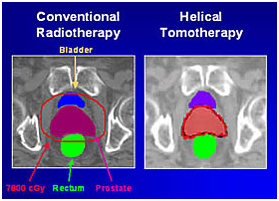Helical TomoTherapy
The TomoTherapy HI-ART System® represents the next generation of leading-edge radiation therapy technology and provides City of Hope oncologists with unprecedented ability to deliver radiation therapy with surgical precision. This means more effective treatment to the tumor, with reduced dose to normal organs, resulting in significantly reduced side effects.
The TomoTherapy system has broad applicability to many forms of cancer, including cancers of the prostate, lung, brain, head and neck, bone and soft tissue, as well as lymphomas, multiple myeloma and some leukemias .
Learn more about the Department of Radiation Oncology.
Request a Consultation
If you have been diagnosed with cancer or are looking for a second opinion consultation about your treatment, call us to request an appointment. Please visit Making Your First Appointment for more information.
How it Works

TomoTherapy essentially is a marriage of two types of technology:
- Spiral CT Scanning
- Intensity Modulated Radiation Therapy
As with a CT scanner, the patient moves through the unit, but instead of a regular x-ray a special therapy x-ray spirally rotates around the patient.
TomoTherapy rotates around the patient - Older methods of radiation therapy attempt to treat a tumor by focusing relatively large beams of radiation from two to six different directions. The TomoTherapy system instead uses hundreds of pencil beams of radiation spirally rotating around the tumor, focusing in from all directions. This video shows the pencil beam patterns produced by TomoTherapy.
TomoTherapy emits pencil beams of radiation - Using these dynamically rotating beamlets, each varying in intensity, oncologists can now deliver radiation with unprecedented precision. The high dose region of radiation can now be shaped or sculpted to fit the exact shape of each patient's tumor. This means a more effective and potentially curative dose to the cancer, with reduced damage to normal tissues and fewer complications. Like an artist, the oncologist is now "painting" radiation with a finer brush, rather than with a wide brush used just a few years ago. He/she is able to paint the tumor with greater precision and keep that paint within the borders of the tumor.

The illustration demonstrates the ability of TomoTherapy to deliver a high dose of radiation to a patient with prostate cancer. The high dose region outlined in red, wraps tightly around the prostate gland with very little radiation hitting the rectum or bladder. In contrast, with previous conventional technology the high dose region would usually include portions of the rectum and bladder.
For some tumor sites, such as cancers of the prostate gland, there can be movement of the gland from day to day due to differences in patient position, and rectum or bladder filling. TomoTherapy is one of the first radiation therapy systems of its kind to incorporate not only radiation therapy, but also tumor imaging capabilities comparable to a diagnostic CT scan. As shown in the accompanying video, TomoTherapy can therefore adjust for day to day changes of the patient's position and internal motion of the target, essentially giving it the ability to remain "locked" on the tumor, to further improve the precision of treatment delivery.
TomoTherapy uses imaging capabilities to remain locked on the tumor - With the ability to see and treat each patient’s cancer with greater precision, the TomoTherapy system offers new hope for patients with many forms of cancer. As the first cancer center in the Western U.S. to offer TomoTherapy and the world’s first facility to perform total marrow irradiation using TomoTherapy, City of Hope oncologists can use this new technology to treat patients with prostate and lung cancer, as well as medulloblastoma, multiple myeloma and lymphomas